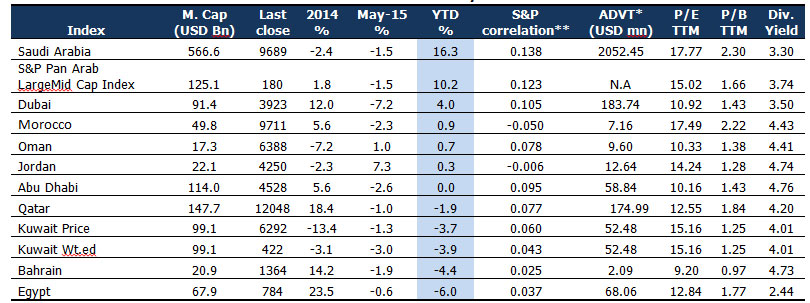_36.jpg)
Kuwait Financial Center "Markaz" issued its monthly market report, which deals with the study and analysis of the performance of stock markets in the Middle East and North Africa region, in addition to global stock markets for the month of May.
The report stated that the performance of Kuwait markets were affected by delay in companies filing their first quarter results, which resulted in investors treading with caution and the drying up of market liquidity. Both the Kuwait weighted and price index fell by 3.0% and 1.3%, respectively, as value and volume traded dropped by over 20%. Brent crude maintained its gains from April, and closed the month down 1.8% from last month. Nil expectations of OPEC production cut, high supplies and stronger US dollar ensured that the oil price remains level at over USD 65 per barrel. OPEC countries pumped at a 2.5 year high of 31.22 million barrels of oil per day (bpd) in May, well above its target of 30 million bpd, underlining the focus of top exporter Saudi Arabia and other key members on market share.
MENA markets had a negative May as nearly all indices, barring Amman and Muscat, closed the month in red. Weak Chinese manufacturing data led to equities across the globe to shed points, while little expectation of an output cut from OPEC caused oil to fall 1.8% in May. Amman index was the only ray of sunshine for MENA markets, ending the month up 7.3%, while Dubai (-7.2%) and Kuwait weighted (-3.0%) indices were the worst hit. The S&P GCC index closed the month at 124 points, registering a 2.3% drop in May. Despite MSCI increasing the weight for the UAE index to 0.72% from 0.65%, low volumes led to slide in the UAE markets, as trading hit a lull ahead of the summer holidays. Both volume and value traded dropped by over 40% this month for both the Abu Dhabi and Dubai exchanges.
Both volume and value traded declined in May by 33% and 18%, respectively, across MENA markets. Bahrain, Qatar and Egypt bucked the trend although this had little effect on their overall index growth. While Qatar market was buoyed at the end of the month by the re-election of Sepp Blatter as the FIFA President, Egypt index fell as its weighting in the MSCI emerging market index declined, with the exclusion of Telecom Egypt from the benchmark.
Blue chips had a negative month as most ended the month in red. Shares of Zain (Kuwait) fell 10% in May, as the company posted a 26.5% decline in Q1 earnings, while Kingdom Holdings (Saudi Arabia) increase in Q1 profit by 10% contributed to its 9.3% increase. Shares of Arabtec Holding (UAE) fell after talks allegedly failed between the firm and the Egyptian housing ministry and the company declared a net loss of USD 76mn in the first quarter of 2015, which has led to calls for managerial improvements in order to restore investor confidence.
Saudi CMA sets market access rules for foreigners
Saudi Arabian CMA announced in July 22, 2014 that it plans to allow for direct investments by foreign institution, which was discussed elaborately in our research titled Saudi Arabian Markets Set to Open. As the country prepares to open its USD 576bn dollar stock exchange to foreign investors, the Capital Market Authority (CMA) reaffirmed the rules for direct foreign investment that it had set in Aug 2014.
- Foreigner investors (residents or otherwise, including interests under swaps) are allowed to own only up to 49% of a single stock, in total
- Qualified institutional foreign investors (banks, brokerages, fund managers and insurance companies) need to have USD 5bn in AUM to invest directly in the stock market. The CMA reserves the right to lower this limit to USD 3bn
- Each QFI (along with affiliates) cannot own greater than 5% of any listed share
- QFIs proportion of ownership in a single stock should not exceed 20%
- QFIs aggregate ownership in shares of all issuers in the exchange should not exceed 10% by market value, including interests under swaps
- Foreigners would be allowed to participate directly in IPOs of Saudi companies on a case-by-case basis
CMA has coordinated with SAMA to allow foreign investors to open bank accounts, and to create a joint database to ensure that account requirements are met. The rules take effect from the 1st of June 2015, but the markets will open to foreign investors on 15th June 2015. Fund managers estimate the market could draw USD 50billion or more of new foreign money in coming years if it is included in global indexes. While this is still seen as the first of many steps, analysts believe it could enter the widely followed MSCI emerging market index as soon as mid-2017, if it satisfies requirements for liquidity and transparency. The kingdom’s Tadawul All Share Index has risen over 16% this year, the best performer thus far among the MENA markets.

Source: Reuters, Zawya, * - Average Daily Value Traded for the month, ** - 3-year daily return correlation
###
About Kuwait Financial Centre “Markaz”
Kuwait Financial Centre K.P.S.C “Markaz”, with total assets under management of over KD 1.12 billion as of March 31, 2015, was established in 1974 has become one of the leading asset management and investment banking institutions in the Arabian Gulf Region. Markaz was listed on the Kuwait Stock Exchange (KSE) in 1997.
For further information, please contact:
Senior Officer
Media & Communications Department
Kuwait Financial Centre K.P.S.C "Markaz"
Tel: +965 2224 8000 ext 1819
Dir: +965 2224 8075
Fax: +965 2241 4499
Email: [email protected]
www.markaz.com

